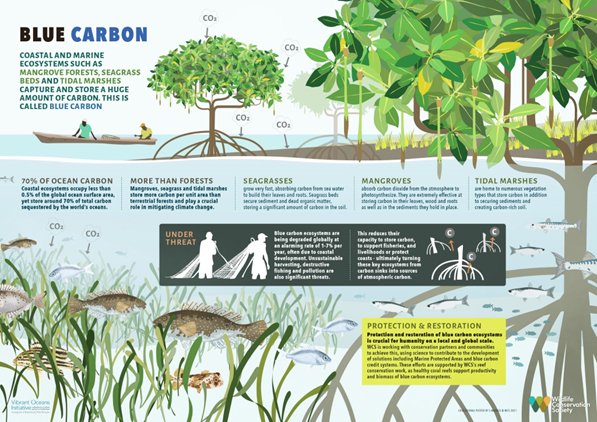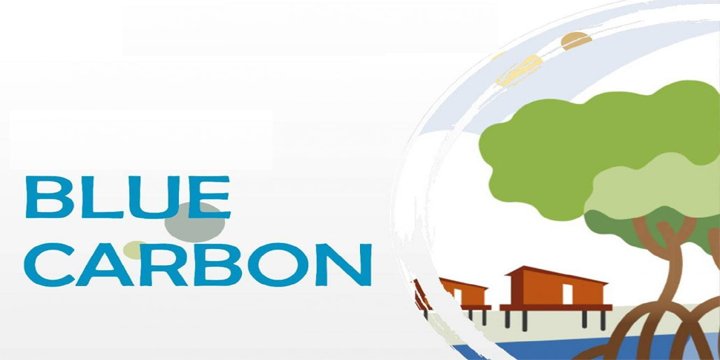BLUE CARBON
What is Blue Carbon ?
- Blue carbon refers to the carbon captured and stored by coastal ecosystems, specifically mangroves, seagrasses, and salt marshes.
- These ecosystems act as some of the most effective carbon sinks, sequestering large amounts of carbon dioxide from the atmosphere and helping to mitigate climate change.
- The importance of blue carbon is gaining increasing recognition in global climate action strategies.

WHY IN NEWS?
- A report titled Blue Carbon and its role in Carbon Sequestration published in June 2024 revealed that mangroves alone have the capacity to store more than 1,000 tons of carbon per hectare.
- They also store 3 to 5 times more carbon per equivalent area than tropical forests, as per the article Coastal Blue Carbons, by the National Oceanic and Atmospheric Administration (NOAA).
BLUE CARBON ECOSYSTEMS
- Mangroves, Seagrasses, and Salt Marshes: These ecosystems collectively make up the “blue carbon” ecosystem.
- They are important in the fight against climate change due to their remarkable ability to capture and store carbon, which helps to offset global emissions.
- Global Mangrove Restoration Potential: If 10% of degraded mangroves worldwide were restored, it could sequester an additional 1.6 billion tons of carbon.
- Additional Environmental Benefits of Mangroves:
- Soil Erosion Prevention: The roots of mangrove trees stabilize coastal soils, reducing erosion and protecting shorelines from storm surges.
- Marine Life Habitat: Mangrove forests provide vital habitats for a wide range of marine species, contributing to biodiversity and providing breeding grounds for fish, crustaceans, and other marine organisms.
ECONOMIC & POLICY CHALLENGES
- Mangrove Loss and Degradation:
- Myanmar’s Mangrove Loss: Myanmar has lost a significant portion of its mangrove forests.
- Once home to over 1.2 million hectares of mangroves, only less than 500,000 hectares remain.
- The Ayeyarwady Delta alone has seen a 64% loss of its 270,000 hectares of mangroves in just 35 years.
- Causes include agricultural expansion, aquaculture, and coastal development driven by economic pressures and population growth.
- Global Drivers of Mangrove Loss: Agricultural land demand, particularly for rice and shrimp farming, has been responsible for 38% of global mangrove loss.
- Challenges in Carbon Credit Systems:
- Blue Carbon Credits: These are instruments used in carbon markets to represent the carbon sequestered by coastal ecosystems, like mangroves and seagrasses.
- They are used to offset emissions from industries and businesses.
- However, blue carbon credit systems face significant economic policy hurdles, such as:
- High Costs and Complex Verification: The process of generating and verifying blue carbon credits is complex, expensive, and often lacks transparency.
- Transparency Issues: For example, the REDD+ project in Cambodia faced issues in proving that its carbon credits contributed effectively to environmental restoration, raising doubts about the integrity of such programs.
- Corruption and Mismanagement: In Bangladesh’s Sundarbans mangrove forest, corruption in the Bangladesh Forest Department (BFD), including illegal logging, bribery, and mismanagement, has severely undermined conservation efforts, accelerating the degradation of this critical ecosystem.
INNOVATIVE SOLUTIONS AND PROGRESS IN BLUE CARBON INITIATIVES
- Australia’s Blue Carbon Method:
- The Blue Carbon Method was developed by the Australian government as part of the Emissions Reduction Fund to simplify the process of including coastal wetland restoration in carbon markets.
- This has encouraged investments in the restoration of ecosystems like mangroves and seagrasses.
- The South Australia Tidal Restoration Project is an example of successful coastal ecosystem restoration, which has received positive results due to clear guidelines and robust verification practices.
- Carbon Credit Issuance: As of December 2024, the Australian Carbon Credit Unit Scheme (ACCU) has issued approximately 16.45 million ACCUs through such projects.
- Technological Innovations:
- AI and Remote Sensing: AI mapping technologies are now used to monitor seagrass meadows and other coastal ecosystems, allowing for more effective tracking of ecosystem health and carbon sequestration.
- Blockchain for Transparency: Blockchain technology is being applied to ensure transparency in the verification and transaction of carbon credits, which helps build trust in the integrity of the carbon credit market.
- Community-Driven Restoration:
- Indonesia’s MERA Program: The Mangrove Ecosystem Restoration Alliance (MERA) has been instrumental in restoring mangrove areas in Indonesia.
- This initiative has improved local economies through sustainable fisheries.
- By early 2024, 262 hectares of mangroves had been restored, and plans were in place for restoring 398,779.78 hectares.
- Community Impact: MERA’s success has connected environmental health with economic stability, benefiting local communities by enhancing fisheries and providing other economic incentives.
ECONOMIC IMPERATIVE OF BLUE CARBON
- Global Market Potential:
- According to McKinsey Sustainability, the global market potential for blue carbon credits could reach $50 billion by 2030.
- This indicates a significant financial opportunity for nations and businesses to invest in the restoration and conservation of blue carbon ecosystems.
- Co-Benefits of Blue Carbon:
- Beyond carbon sequestration, blue carbon ecosystems offer several co-benefits, including job creation, sustainable tourism, and enhanced fisheries management, which make them appealing to both governments and private investors.
- India’s Eco-Tourism: In India, restored mangrove ecosystems are increasingly being viewed as a valuable asset for eco-tourism.
- The country’s government has provided funding for mangrove restoration under the Coastal Regulation Zone Policy reforms introduced in 2023. This has helped attract both national and international investment.
- The MISHTI Scheme in India:
- Launched in 2023, the Mangrove Initiative for Shoreline Habitats and Tangible Incomes (MISHTI) aims to restore 540 sq km of mangroves across nine states and four Union Territories in India by 2028.
- By December 2024, 250 sq km of mangroves had already been restored under the MISHTI program.
- This initiative is expected to continue making significant strides toward restoring India’s vital coastal ecosystems.
- Economic Return on Investment:
- According to a report by the OECD (2024), every $1 invested in blue carbon restoration can yield up to $6 in economic returns, demonstrating the high economic value of investing in blue carbon restoration projects.
Note: Connect with Vajirao & Reddy Institute to keep yourself updated with latest UPSC Current Affairs in English.
Note: We upload Current Affairs Except Sunday.


